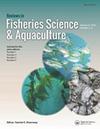The Race for Space: Using Acoustic Telemetry to Understand Density-Dependent Emigration and Habitat Selection in a Released Predatory Fish
引用次数: 30
Abstract
The dynamics of fish behavior, migration, and habitat use following stock enhancement will influence the outcome of recovery programs and indicate the ecological limits of the system. This study tested the effect of release density on emigration, activity patterns, and space utilization by releasing juvenile mulloway (Sciaenidae: Argyrosomus japonicus) at low and high densities and monitoring movement intensively for 336 h post release. Mulloway released at high densities had faster emigration and greater overall emigration rates than low density releases. Also, mulloway released at high densities used sub-optimal habitats at a greater frequency. Released fish dispersed into habitat patches at densities proportional to the quality of the habitat patch, consistent with density-dependent habitat selection. Targeting releases of small numbers of fish to the carrying capacity of individual patches of habitat will contribute to the success and economic viability of release programs in open systems. Releases of high densities of individuals or repeated releases at the same site may lead to increased emigration and losses from the stocked system. The capacity of a target habitat to support released fish can be rapidly assessed using pilot releases and intensive monitoring of acoustically tagged fish, prior to the implementation of large-scale release programs.空间竞赛:利用声学遥测技术了解释放的掠食性鱼类的密度依赖迁移和栖息地选择
鱼类行为、迁徙和栖息地利用的动态变化将影响恢复计划的结果,并表明该系统的生态极限。本研究通过低密度和高密度放生海螺幼鱼,并在放生后336 h集中监测放生密度对海螺洄游、活动模式和空间利用的影响。高密度释放的Mulloway比低密度释放的Mulloway迁移速度更快,总体迁移率更高。此外,高密度释放的mulloway在更大的频率上使用了次优栖息地。放生鱼分散到生境斑块的密度与生境斑块的质量成正比,符合密度依赖的生境选择。将少量鱼类的放生定位于单个生境的承载能力,将有助于开放系统放生计划的成功和经济可行性。高密度个体的释放或在同一地点的重复释放可能导致种群迁移增加和存量系统的损失。在实施大规模放生计划之前,可以通过试点放生和对声学标记鱼类的密集监测来快速评估目标栖息地支持放生鱼类的能力。
本文章由计算机程序翻译,如有差异,请以英文原文为准。
求助全文
约1分钟内获得全文
求助全文

 求助内容:
求助内容: 应助结果提醒方式:
应助结果提醒方式:


